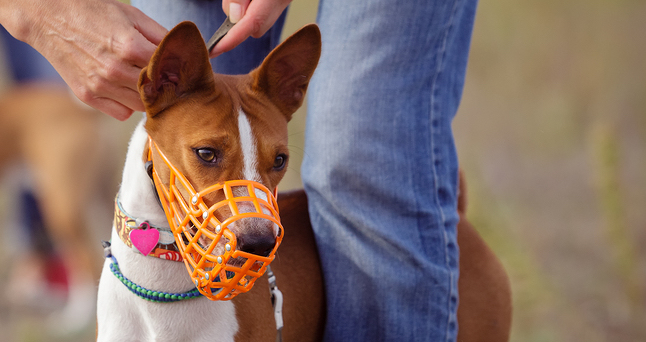
Sometimes when asked how work is going, I answer, “Not too bad. I still have all ten fingers.” It’s my poor attempt at a joke, but I’ve realized that a lot of people unfamiliar with veterinary medicine ask if that’s really a risk of the job. Although we have countless wonderful pets that walk through our doors, the reality is that some patients are more difficult – and more dangerous – to handle than others.
The reason I wanted to discuss this is that some people think when we muzzle a dog, it’s cruel. It’s not. It’s a matter of safety. We all love animals and love the patients we work with, but that doesn’t mean we’re willing to take a trip to the emergency room instead of muzzling a pet.
When I was first out of school, I was apprehensive about relying on the muzzle. I thought muzzling a dog was admitting a deficiency in my animal training skills. But no matter how many treats you try to bribe your patients with or how “Fear Free” your practice is, some dogs will still be much better patients when wearing a muzzle.

There are multiple reasons why we use muzzles beyond the obvious case of an aggressive dog. Even the sweetest dog has the potential to bite if they are in severe pain, so many painful patients are given a muzzle as a precaution. Some dogs that pose no threat to bite are simply calmer when they are wearing a muzzle. It’s difficult to draw blood from wiggly puppies, but one trick that may make them more stationary is distracting them with a muzzle. Many routine exams and treatments become a lot quicker when a nervous dog is muzzled, so we can get that dog out of the office and back to the comfort of home even sooner.
The word “muzzle” seems to have a negative connotation. Many veterinary professionals try to remove that negativity by calling it something that sounds a little less harsh – the favorite term for the techs at my practice is “party hat”. However, I don’t think we should shy away from the word. When I was a naïve new graduate not too long ago, I assumed that owners would be offended if I told them I needed to muzzle their dog.
Yes, some clients are anxious and need some reassurance that the muzzle won’t hurt their beloved pet, but most are quite understanding if you explain or even show them how much easier and safer it is to work with their pet when a muzzle is used.
I can personally relate to owners whose dog requires a muzzle because I am one of those owners! My dog cannot stand his nails being trimmed. No matter how much peanut butter we use to distract him, he can be a real pain – and quite honestly, a danger – to anyone trying to trim his nails. But, when he is wearing a muzzle, he’s a completely different dog. He is more relaxed and less reactive making the procedure less stressful for him and easier for us.
The muzzle allows us to give him a much quicker, better, and safer nail trim – a win for everyone! I have even started using my uncooperative dog to my advantage by saying to clients, “It’s not a big deal that your dog needs a muzzle. My own dog gets a muzzle when he’s here.”
So, let your clients know that if their dog requires a muzzle, it’s not something to be embarrassed about. If the appointment is easier, faster, and less stressful for the patient (and us), then the muzzle is definitely a good thing! And, your fellow veterinary team members will be very appreciative if the muzzle keeps them from losing a finger.
The views and opinions expressed in this article are those of the author and do not necessarily reflect the position of the DrAndyRoark.com editorial team.

Dr. Michael W. Miller, DVM is a part-owner of a four hospital practice and splits time between Lakewood Animal Hospital and Pine Bluff Animal Hospital in Morris, Illinois. He has a special interest in exotic animal medicine – especially reptiles, but he also enjoys working on dogs and cats including his mischievous shelter mutt named Wombat.